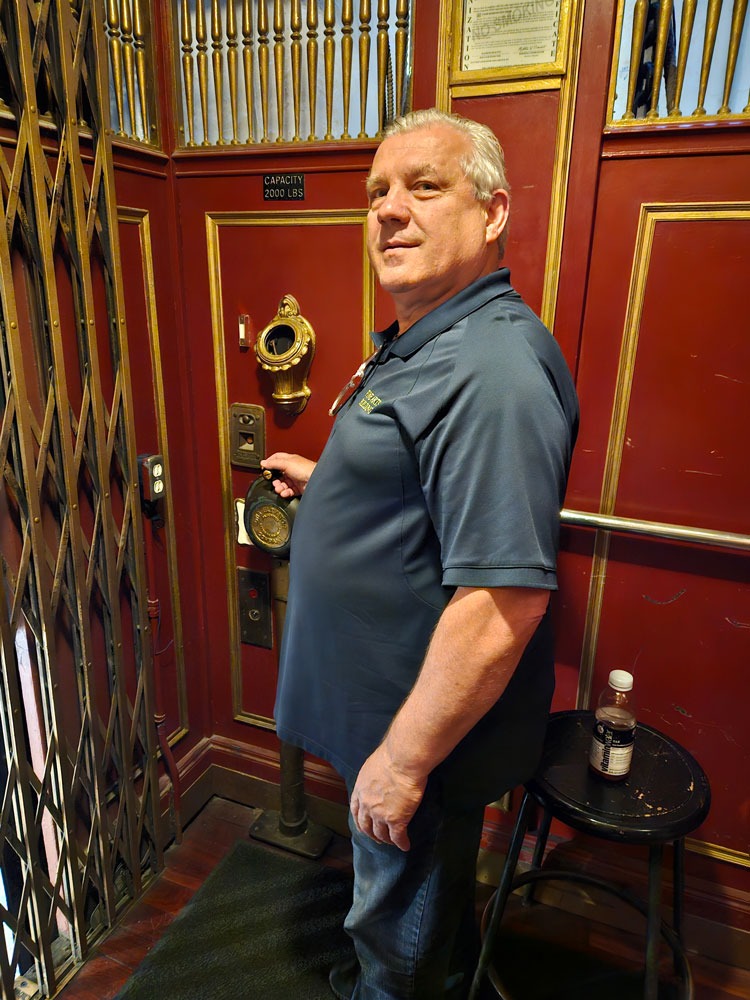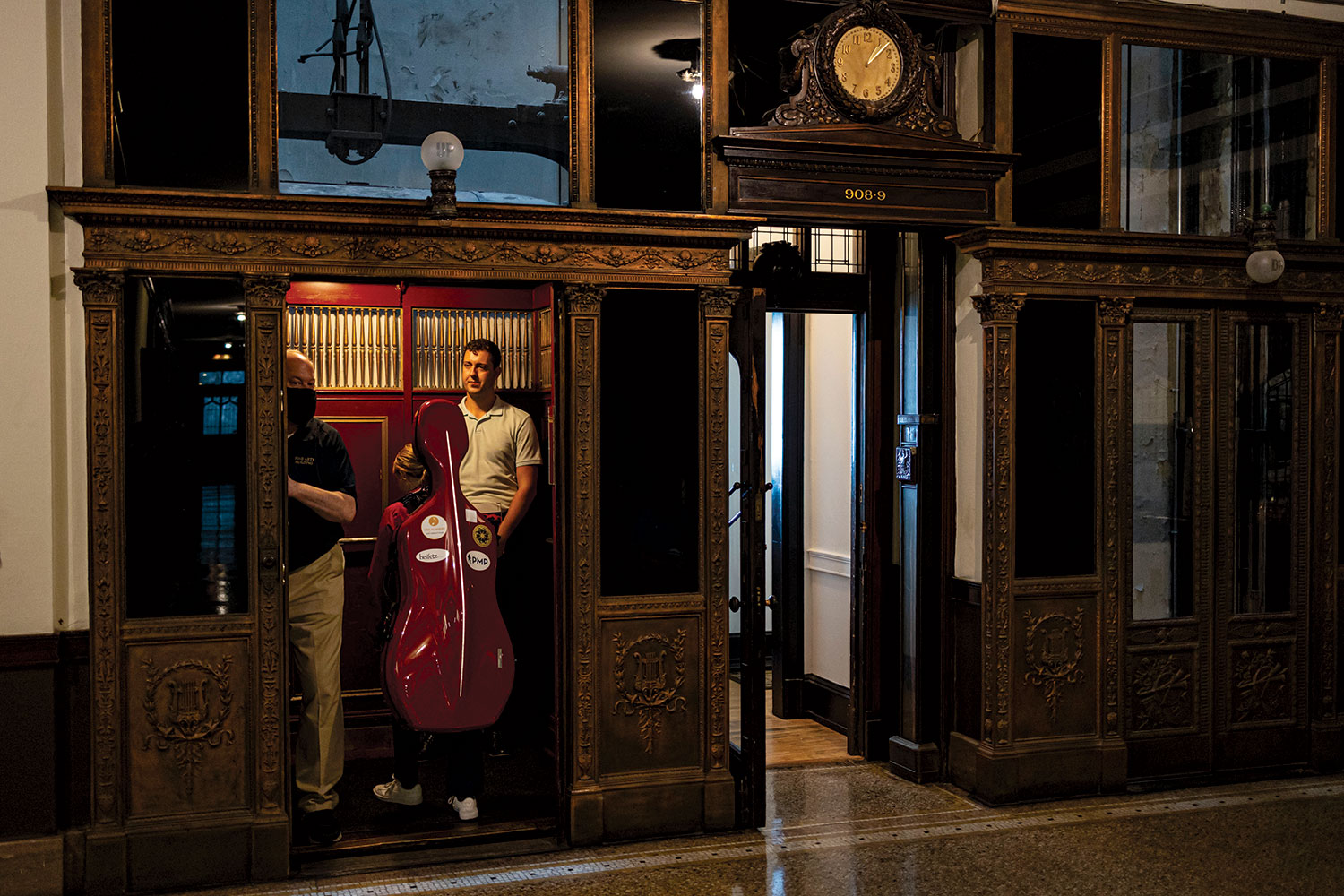Somewhere, on some floor of the 10-story Fine Arts Building, a brassy bell rings. Someone wants to ride the elevator. Waclaw Kalata yanks the handcrank and cruises up and down the elevator shaft, searching for his prospective passenger. A mirror embedded in the car’s frame, known as “the spyglass,” allows him to spot people standing off to the side of the doorway.
“I’m look in the mirror, I see some of the people there,” explains Kalata, who still speaks with a heavy Polish accent, despite living in Chicago for decades.
Kalata finds his passenger, opens the glass door, and delivers her to the lobby, where he picks up five more riders. For the past 30 years, Kalata has worked as an elevator operator in the Fine Arts Building, the last building in Chicago offering manually operated elevator rides to the public. By the end of next year, though, his occupation will disappear. After 125 years, the Fine Arts Building is switching to automated elevators. That’s a practical decision, says managing artistic director Jacob Harvey, but a regrettable one. It’s difficult to find parts for the vintage Otis Elevators, and the mechanic who repairs them is about to retire.
The elevators were installed in 1898, when the old Studebaker Carriage Works was converted to artists’ studios. They’ve been run by elevator operators ever since. Despite the necessity of replacing them with push-button models, Harvey understands that when the building loses its operators, it will lose some of its character, too.
“They are such a staple of this building, and part of the ecosystem,” he says. “They’re people’s first point of contact in this building. People who have stories about this building have stories about elevator operators. It’s that human touch. There’s so much artistry and artistic legacy. There’s this human interaction that’s part of a bygone era. You build a relationship with them. You talk to the artists about relationships they have with the operators.”

Tommy Durkin, an Irish immigrant who once ran Elevator #1, was so well-known and well-loved in the building that the lobby is named Durkin Hall in honor, with a plaque displaying his face and discussing his creation of the basement “Notre Dame room,” a shrine to his favorite college football team. Every morning, when Kalata arrives at work at 7 a.m., he rubs Tommy’s nose “for good luck.” Decades of luck have worn the protuberance to shiny brass.
“Tommy, he trained me,” Kalata says. “Showed me every trick: how to land, how to close the gate.”
When Kalata picks up violinist Nora Williams, he knows she’s going to her ninth-floor studio. An automated elevator won’t know that, nor will it share building gossip.
“The friendliness, the catching up, the warmth, the feeling of being protected” are the value of an operator, Williams says. “The elevator operators know where to find my studio. The button doesn’t know where. The elevator operators see everyone. They’re the real glue that keeps this community together.”
The building is already converting the first of its three elevators, Harvey says. Some time next year, an operator will take his passengers on the last manual ride. Management is in discussions with Elevator Operators Union Local 1 to find new jobs for the three full-time operators. Kalata, who is 64, plans to retire: “I’m working 30 years my job.”
Not Nevada Bradley. Bradley started in the Fine Arts Building as a security guard, and started running the elevators in 2020. Now, he says, “I’m a fixture.”
“I didn’t want to do it,” he says. “I was scared I was gonna boom” — land the elevator below the first floor, in which case it has to be restarted by an engineer. “You can either go too high or too low.”
Bradley did it, though, and now he considers himself a master of manual elevating.
“You gotta have it in the wrist,” he explains. “I’m a Leo, so naturally, I’m a perfectionist. So I perfected it.”
During a ride to the 9th Floor, Bradley allows Harvey to operate the elevator. Twice, Harvey stops the elevator short of the floor: “That’s why you gotta leave it to the professionals.”
Then he adds, “That’s what I like about this job. It has its ups and and it has its downs.”
(Elevator operators are all about service. By making that joke, Bradley spared me the embarrassment of doing it myself.)
Like his passengers, Bradley considers himself an artist. Even though he’s been running the elevators only four years, he considers himself such a building celebrity that he donated his portrait to Exile on Bookville, the building’s bookstore, which plans to display it on the wall.
“The elevator’s as much a part of the art as anything else in this building,” Harvey acknowledges. “It’s experiential. It’s a performance, and it’s the only place in Chicago you can have this moment.”
When the manual elevators are retired, management plans to display one in a fifth-floor exhibit on the building’s history. Stepping into a stationary elevator won’t be the same as riding with an operator, though.
“I’ll miss these old babies when they put ’em out to pasture,” Bradley says. “They won’t go anywhere. Tell your readers to get in here so me and Waclaw and Jacob can give ’em their last ride.”



